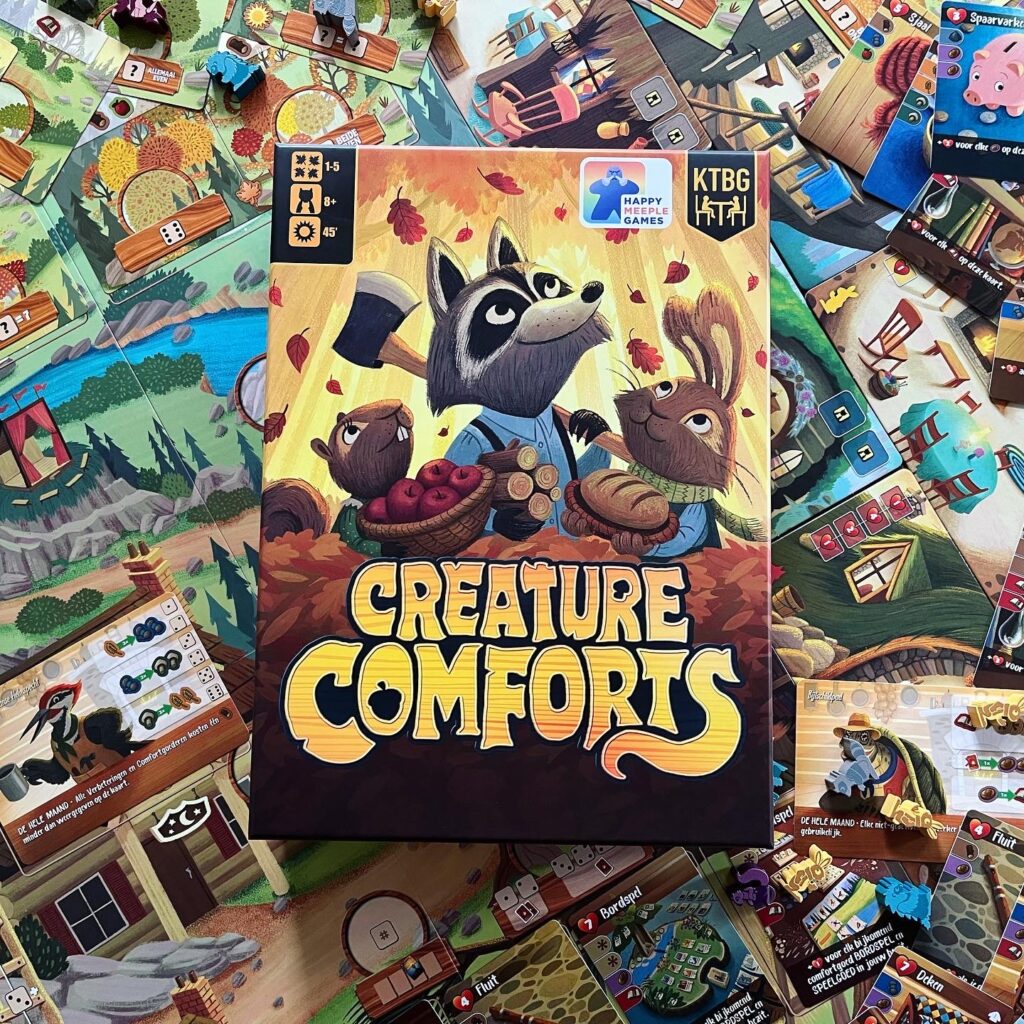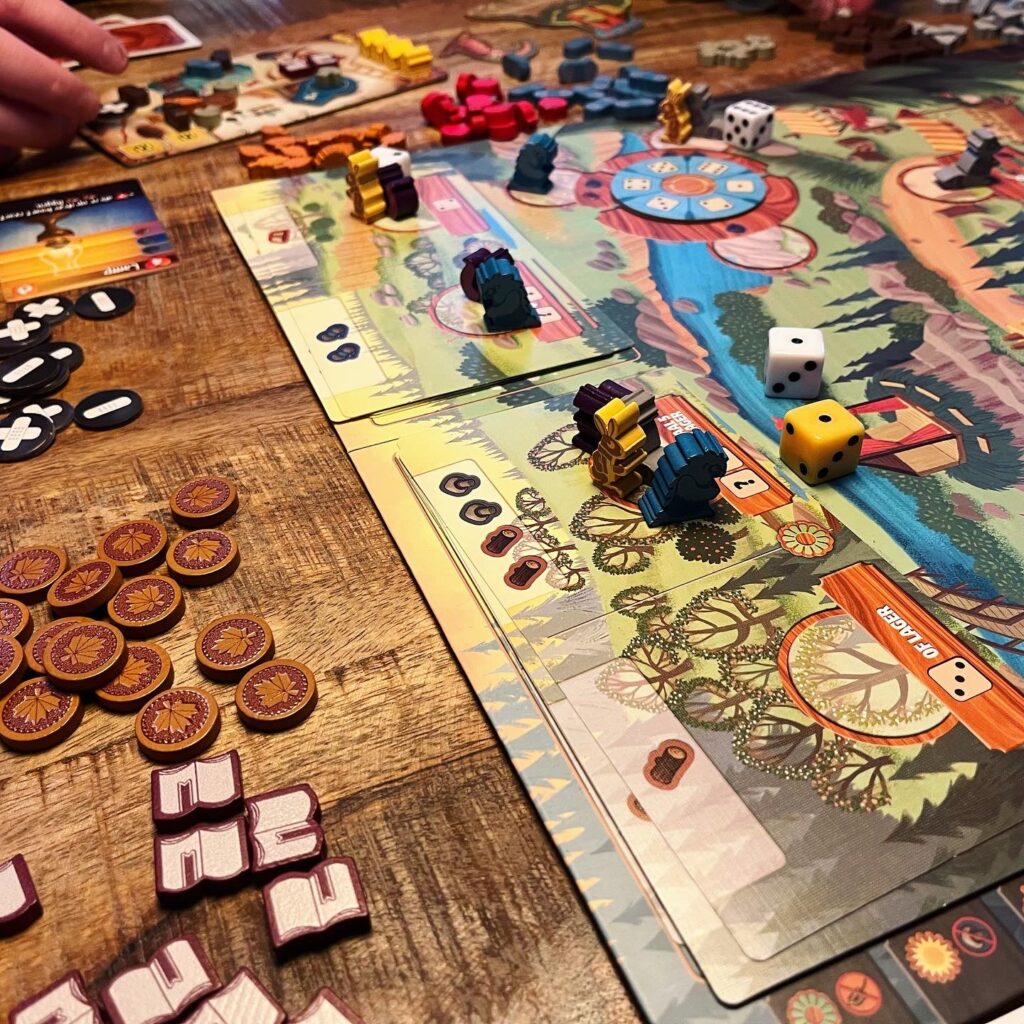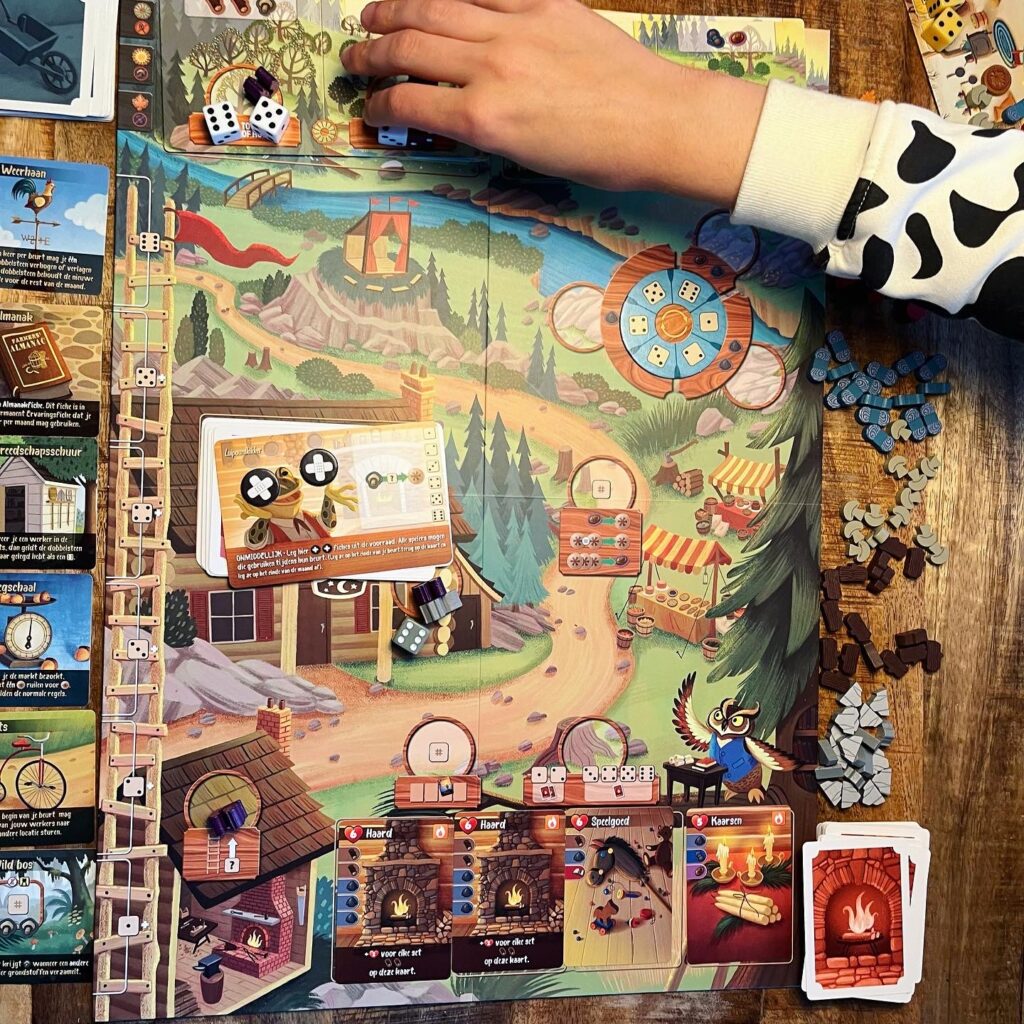Like every afternoon, Raccoon went to visit Fox. Fox was already busy when Raccoon knocked on her door. “What are you doing, Fox?” asked Raccoon. Fox looked up from her chores and glazed in Wasbeer’s direction. “I’m getting ready for winter” said Fox “have you started yet?” Raccoon thought long and hard until smoke almost rose from his ears, but came to the realisation that he was not yet ready for winter. Fox’ question made Raccoon panic slightly. The other day, Raccoon finished gobbling up his entire pantry including the remaining winter supply. Of the saved honey, dried berries, chestnuts, jam, sweet onions, winter carrots and wheat flour, only the emptied glass mason jars were left. Just when Fox had poured some fresh tea for them to enjoy, Raccoon jumped up and took his confused leave. Fox remained behind almost perplexed. When Raccoon returned home and looked at his calendar, he sighed with relief: spring had only just begun.

In the extremely popular Creature Comforts players ready themselves ready for winter. How comfortable is your winter?
Goal and setup
In eight (or six) months (rounds) players get ready for winter. During spring, summer and autumn they prepare themselves for the approaching cold and hard times. How do these clever animals survive the winter? Firstly, they will hoard enough food and fill their cupboards with the tastiest delicacies. Secondly, the animals make themselves comfortable and fill their houses with cosy accessories, comfortable furniture, warm blankets and, of course, enough reading material and toys. Winter is actually a cosy time and it is not entirely unlikely that the various creatures look forward to this period.
Creature Comforts takes the worker placement game mechanism as its starting point but with a twist. By placing their wooden creatures on the game board during the various rounds, players can collect resources. They can then use these resources to play comfort cards or buy improvement cards. With these cards they can prepare themselves for winter and unlock special actions and points. The player with the most points at the end of the autumn (fall) wins.
The village (the game board) is placed in the middle of the table. In the village there are several locations where the players can collect resources. However, the game board and the actions are varied and change through the game. There are a number of fixed locations, but every round a new traveller enters the village that unlocks special actions. In addition, the seasons change and so do the actions. On top of the game board, there are season cards with available actions that change each round. The change-up of these cards also causes scarcity of certain resources per season. The game therefore contains more than enough variation, so that each game of Creature Comforts brings new insights, strategies and tactics.
Gameplay
Creature Comforts is a worker placement game with a twist. Each round, a new traveller comes to the village. Next, players roll the two family dice (dice in their own colour). In normal worker placement games, players take turns placing their workers to get resources as soon as the worker is placed. Often, there is limited space for workers on the game board, so players can block each other. In Creature Comforts, players place their workers on the board simultaneously and cannot ‘block’ each other per se. A side note: players place their workers only to indicate which actions they can possibly perform during their turn, the action is not yet executed by placing the worker.

Actions are carried out by using the available dice. The various action spaces show the conditions that players must fulfil with the available dice (for example, placing dice of specific values). At the beginning of a round, everyone rolls their two family dice. This allows them to presume which actions they may be able to take. During a round, but only after the workers have been placed, the general dice are rolled. Players take turns using their available dice (i.e. family dice and general dice) to perform actions. Players can only take actions where their workers are, and there is a good chance that some workers and the chosen actions will remain unused.
However, players have a wide range of possibilities to use their dice and can also influence the values of a roll. If a player can’t (or doesn’t want to) use a certain die, he gets a token that he can exchange later on during the game to change the value of a die.

With the actions, players can collect resources or other objects. Players can also exchange resources and objects or buy comfort cards and/or improvement cards. With the collected resources, the acquired comfort cards can be played. With these cards, players can try to collect the most points to win the game.
Verdict
Creature Comforts is a beautiful production. The quality of the components (especially of the deluxe wooden version) is impressive. The theme is very cosy and comforting and the beautiful illustrations by Shawna J.C. Tenney evoke nostalgic feelings of classic children’s books, picture books and fables. Creature Comforts reminds me, for example, of the works of Dutch author Toon Tellegen, whose works, in which animals often play the leading role, deal with everyday, absurdist and philosophical issues. It is not without a reason that the intro of this review is inspired by the works of Tellegen. All of this ensures that Creature Comforts is a very inviting game right from the first impressions.

A comparison with Everdell is quickly drawn up. Just like Creature Comforts, Everdell is a worker placement game where animals in the different seasons prepare themselves for the winter. Resources are collected and cards are played with the acquired resources. The comparison between Everdell is in principle justified, but at the same time unjustified. Both games use a similar mechanism and theme as a starting point, but the actual end result is widely different. Some game fanatics write that Creature Comforts is a less complex version of Everdell, but I strongly disagree.
Everdell is a classic worker placement, each turn players play their workers at scarce locations. The twist on Everdell’s genre is twofold. On one hand, Everdell does not have a classical structure of rounds. Players decide for themselves when to change seasons and rounds. As a result, some players enter different phases of the game and may have different possibilities. Furthermore, the heart of Everdell lies in the cards. With the cards, players build a real point and action system. Everdell is therefore much more of an engine builder than a worker placement. Strategy plays a much more important role in Everdell. Luck and thus tactics certainly play a role, but the player with the longest breath will often take first place on the stage. Players can block each other and there are even expansions and cards that allow players to directly influence other players. This makes Everdell relatively interactive for a worker placement.
Creature Comforts is also a worker placement with a twist. Luck and how to mitigate said luck play an important role. The dice (and thus luck) significantly limit a player’s options in a positive way. Players are therefore much more dependent on tactics than on strategy. At the beginning of a round, players must estimate what actions they might take, but they must also be wary of having to change their tactics. All players are in the same boat, so at no point does the game feel unfair. The twisting of the game mechanism gives me a different game experience than Everdell, and both games have a clear right to exist and a deserved spot in your collection. Creature Comforts is also no less complex. The complexity is manageable: the game is easy to learn and the gameplay itself is intuitive, but there are enough choices, components and elements that players must take into account. So it is well suited for experienced players, but also for families with children with sufficient playing experience. Above all, it is a good challenge for everyone.
Because of the different travellers and seasons, Creature Comforts is also very varied. The interaction between players is however limited to the availability of cards on the ‘market’: you might buy a card that other players wanted, but there are enough cards for everyone. This makes Creature Comforts a comfortable and friendly game without too much confrontation. A small disadvantage of Creature Comforts is the game duration. During another player’s turn, you’re mostly waiting, and because of the lack of interaction, another player’s turn is also less engaging. This is why I prefer to play Creature Comforts with 2 or 3 players. With that number, it is a relaxing and cosy game.
Creature Comforts is highly relaxing, enjoyable colourful and cheerful game.

What do the others think:
“Creature Comforts, with its art work and game design, also gives a certain comfortable feeling, which attracts me personally. However, don’t play Creature Comforts with too many players, or you will have a lot of waiting time. In my opinion, it is also very difficult to find the right target group, I can imagine that for less experienced children it is sometimes too difficult and long to wait. I myself have enjoyed myself despite the waiting time.”
Chris
“Creature Comforts is a nice alternative to proven worker placement games such as Architects of the Western Kingdom and Euphoria. With 2-3 players, the game is quite enjoyable and the theme is very inviting. With 4 or 5 players it sometimes takes just a bit too long. If you are completely new to worker placement games, I may recommend you start with one of the aforementioned games, as they are easier to play and less complex, otherwise you can dive straight into Creature Comforts.”
Rick




